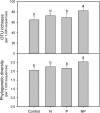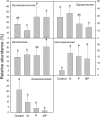Rapid response of arbuscular mycorrhizal fungal communities to short-term fertilization in an alpine grassland on the Qinghai-Tibet Plateau
- PMID: 27478711
- PMCID: PMC4950554
- DOI: 10.7717/peerj.2226
Rapid response of arbuscular mycorrhizal fungal communities to short-term fertilization in an alpine grassland on the Qinghai-Tibet Plateau
Abstract
Background: The Qinghai-Tibet Plateau (QTP) is home to the vast grassland in China. The QTP grassland ecosystem has been seriously degraded by human land use practices and climate change. Fertilization is used in this region to increase vegetation yields for grazers. The impact of long-term fertilization on plant and microbial communities has been studied extensively. However, the influence of short-term fertilization on arbuscular mycorrhizal fungal (AMF) communities in the QTP is largely unknown, despite their important functional role in grassland ecosystems.
Methods: We investigated AMF community responses to three years of N and/or P addition at an experimental field site on the QTP, using the Illumina MiSeq platform (PE 300).
Results: Fertilization resulted in a dramatic shift in AMF community composition and NP addition significantly increased AMF species richness and phylogenetic diversity. Aboveground biomass, available phosphorus, and NO3 (-) were significantly correlated with changes in AMF community structure. Changes in these factors were driven by fertilization treatments. Thus, fertilization had a large impact on AMF communities, mediated by changes in aboveground productivity and soil chemistry.
Discussion: Prior work has shown how plants often lower their reliance on AMF symbioses following fertilization, leading to decrease AMF abundance and diversity. However, our study reports a rise in AMF diversity with fertilization treatment. Because AMF can provide stress tolerance to their hosts, we suggest that extreme weather on the QTP may help drive a positive relationship between fertilizer amendment and AMF diversity.
Keywords: Arbuscular mycorrhizal fungi; Community; Diversity; Fertilization; Plateau.
Conflict of interest statement
The authors declare that they have no competing interests.
Figures





References
-
- Avio L, Castaldini M, Fabiani A, Bedini S, Sbrana C, Turrini A, Giovannetti M. Impact of nitrogen fertilization and soil tillage on arbuscular mycorrhizal fungal communities in a Mediterranean agroecosystem. Soil Biology and Biochemistry. 2013;67:285–294. doi: 10.1016/j.soilbio.2013.09.005. - DOI
-
- Bai YF, Wu JG, Clark CM, Naeem S, Pan QM, Huang JH, Zhang LX, Han XG. Tradeoffs and thresholds in the effects of nitrogen addition on biodiversity and ecosystem functioning: evidence from inner Mongolia Grasslands. Global Change Biology. 2010;16(1):358–372. doi: 10.1111/j.1365-2486.2009.01950.x. - DOI
-
- Beauchamp EG, Trevors JT, Paul JW. Carbon sources for bacterial denitrification. Advances in Soil Science. 1989;10:113–142. doi: 10.1007/978-1-4613-8847-0_3. - DOI
LinkOut - more resources
Full Text Sources
Other Literature Sources
Miscellaneous

